CHEVROLET S10 2003 2.G Workshop Manual
Manufacturer: CHEVROLET, Model Year: 2003, Model line: S10, Model: CHEVROLET S10 2003 2.GPages: 432, PDF Size: 2.82 MB
Page 51 of 432
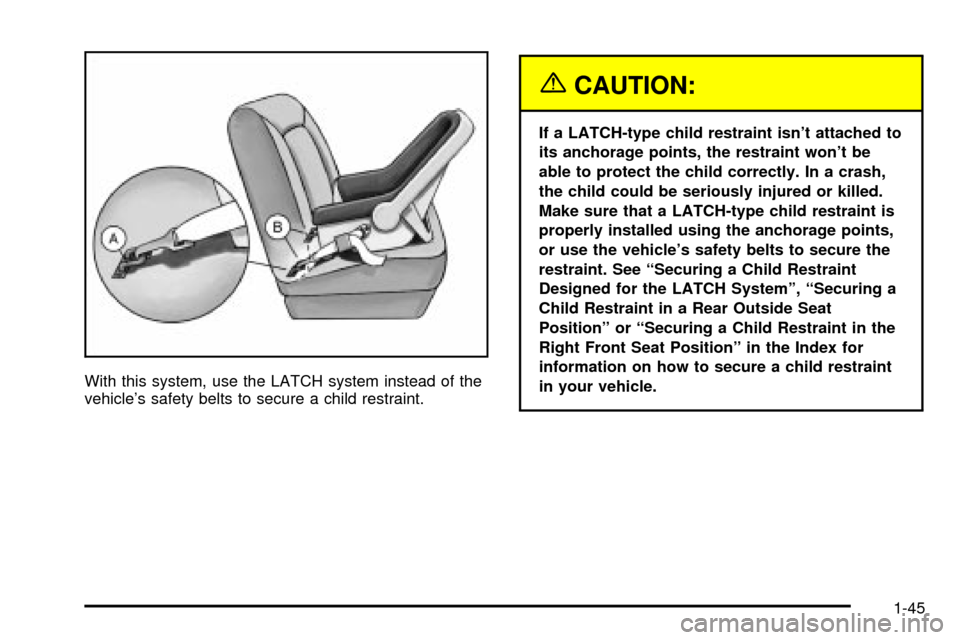
With this system, use the LATCH system instead of the
vehicle's safety belts to secure a child restraint.
{CAUTION:
If a LATCH-type child restraint isn't attached to
its anchorage points, the restraint won't be
able to protect the child correctly. In a crash,
the child could be seriously injured or killed.
Make sure that a LATCH-type child restraint is
properly installed using the anchorage points,
or use the vehicle's safety belts to secure the
restraint. See ªSecuring a Child Restraint
Designed for the LATCH Systemº, ªSecuring a
Child Restraint in a Rear Outside Seat
Positionº or ªSecuring a Child Restraint in the
Right Front Seat Positionº in the Index for
information on how to secure a child restraint
in your vehicle.
1-45
Page 52 of 432
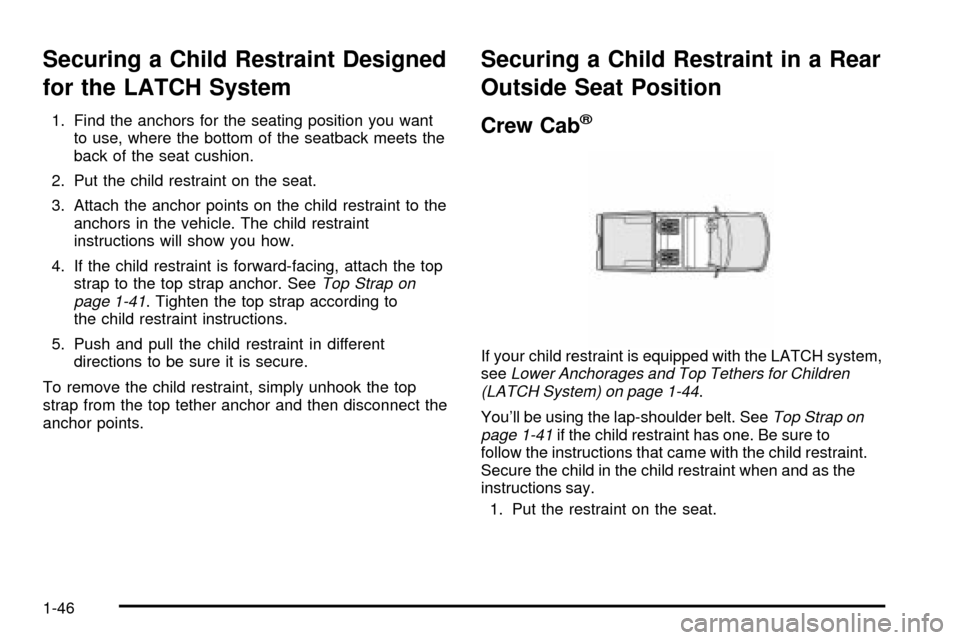
Securing a Child Restraint Designed
for the LATCH System
1. Find the anchors for the seating position you want
to use, where the bottom of the seatback meets the
back of the seat cushion.
2. Put the child restraint on the seat.
3. Attach the anchor points on the child restraint to the
anchors in the vehicle. The child restraint
instructions will show you how.
4. If the child restraint is forward-facing, attach the top
strap to the top strap anchor. See
Top Strap on
page 1-41. Tighten the top strap according to
the child restraint instructions.
5. Push and pull the child restraint in different
directions to be sure it is secure.
To remove the child restraint, simply unhook the top
strap from the top tether anchor and then disconnect the
anchor points.
Securing a Child Restraint in a Rear
Outside Seat Position
Crew Cabž
If your child restraint is equipped with the LATCH system,
seeLower Anchorages and Top Tethers for Children
(LATCH System) on page 1-44.
You'll be using the lap-shoulder belt. See
Top Strap on
page 1-41if the child restraint has one. Be sure to
follow the instructions that came with the child restraint.
Secure the child in the child restraint when and as the
instructions say.
1. Put the restraint on the seat.
1-46
Page 53 of 432
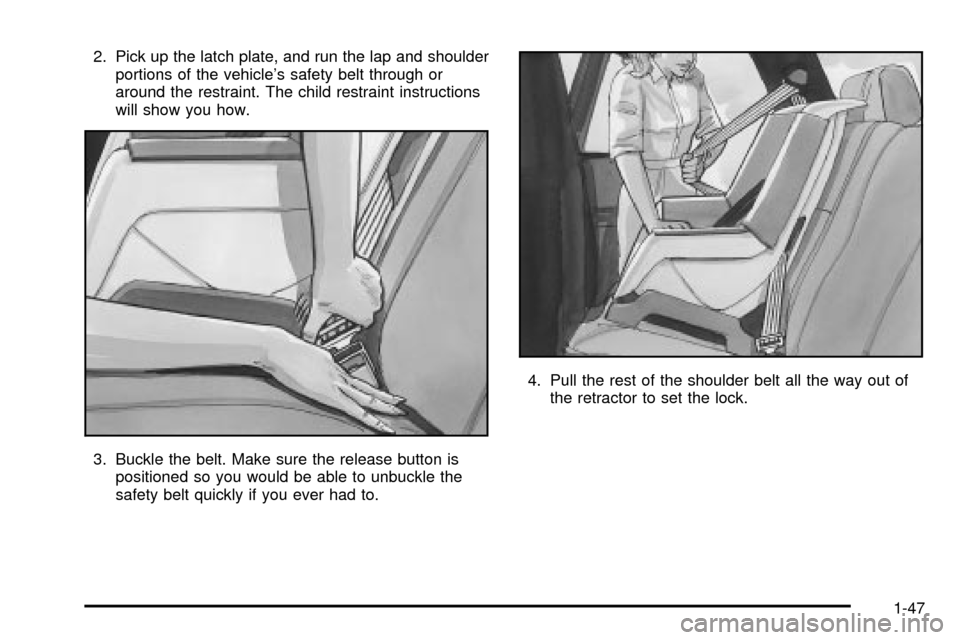
2. Pick up the latch plate, and run the lap and shoulder
portions of the vehicle's safety belt through or
around the restraint. The child restraint instructions
will show you how.
3. Buckle the belt. Make sure the release button is
positioned so you would be able to unbuckle the
safety belt quickly if you ever had to.4. Pull the rest of the shoulder belt all the way out of
the retractor to set the lock.
1-47
Page 54 of 432
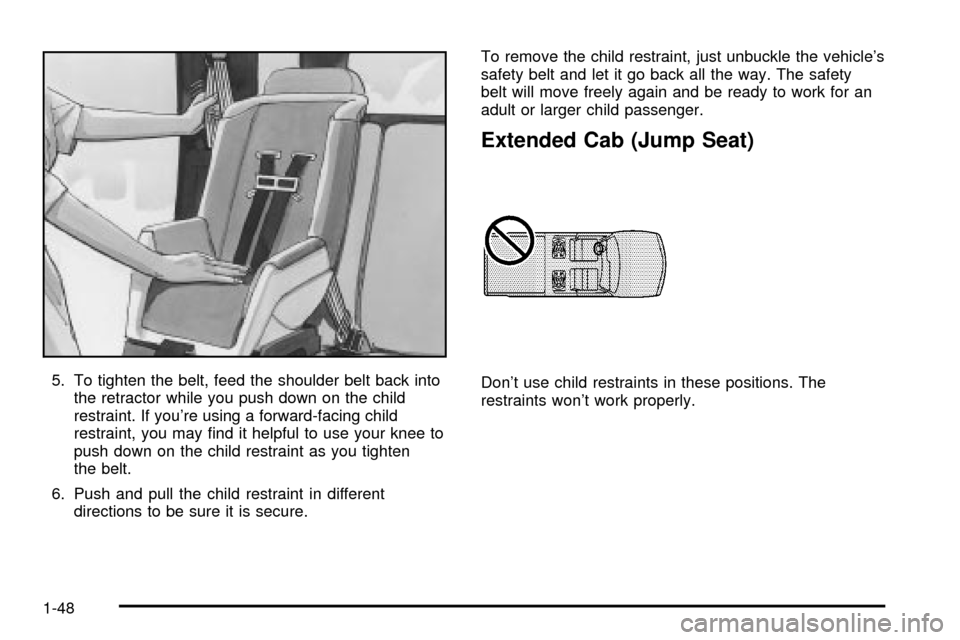
5. To tighten the belt, feed the shoulder belt back into
the retractor while you push down on the child
restraint. If you're using a forward-facing child
restraint, you may ®nd it helpful to use your knee to
push down on the child restraint as you tighten
the belt.
6. Push and pull the child restraint in different
directions to be sure it is secure.To remove the child restraint, just unbuckle the vehicle's
safety belt and let it go back all the way. The safety
belt will move freely again and be ready to work for an
adult or larger child passenger.
Extended Cab (Jump Seat)
Don't use child restraints in these positions. The
restraints won't work properly.
1-48
Page 55 of 432
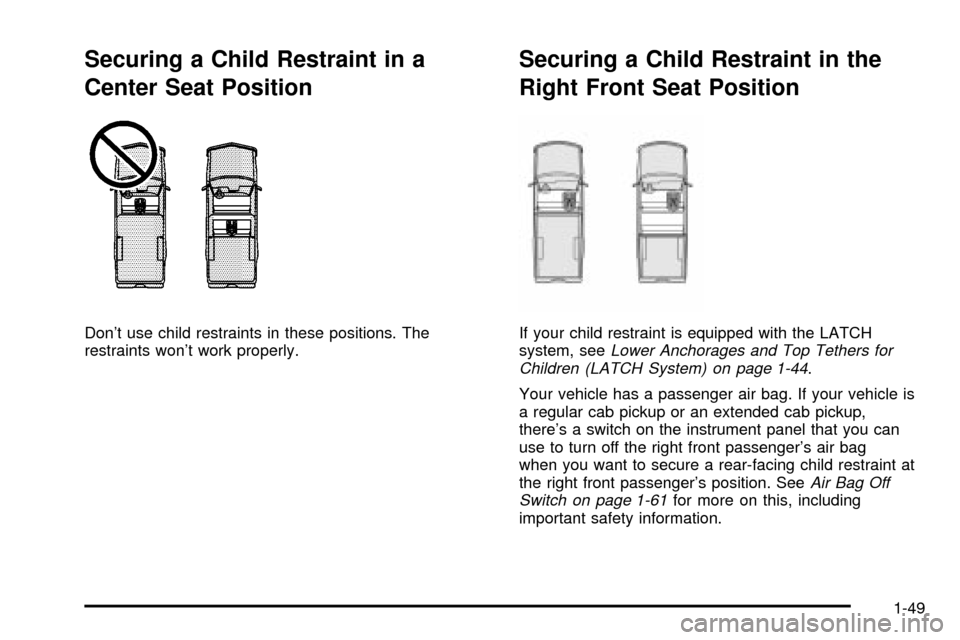
Securing a Child Restraint in a
Center Seat Position
Don't use child restraints in these positions. The
restraints won't work properly.
Securing a Child Restraint in the
Right Front Seat Position
If your child restraint is equipped with the LATCH
system, seeLower Anchorages and Top Tethers for
Children (LATCH System) on page 1-44.
Your vehicle has a passenger air bag. If your vehicle is
a regular cab pickup or an extended cab pickup,
there's a switch on the instrument panel that you can
use to turn off the right front passenger's air bag
when you want to secure a rear-facing child restraint at
the right front passenger's position. See
Air Bag Off
Switch on page 1-61for more on this, including
important safety information.
1-49
Page 56 of 432
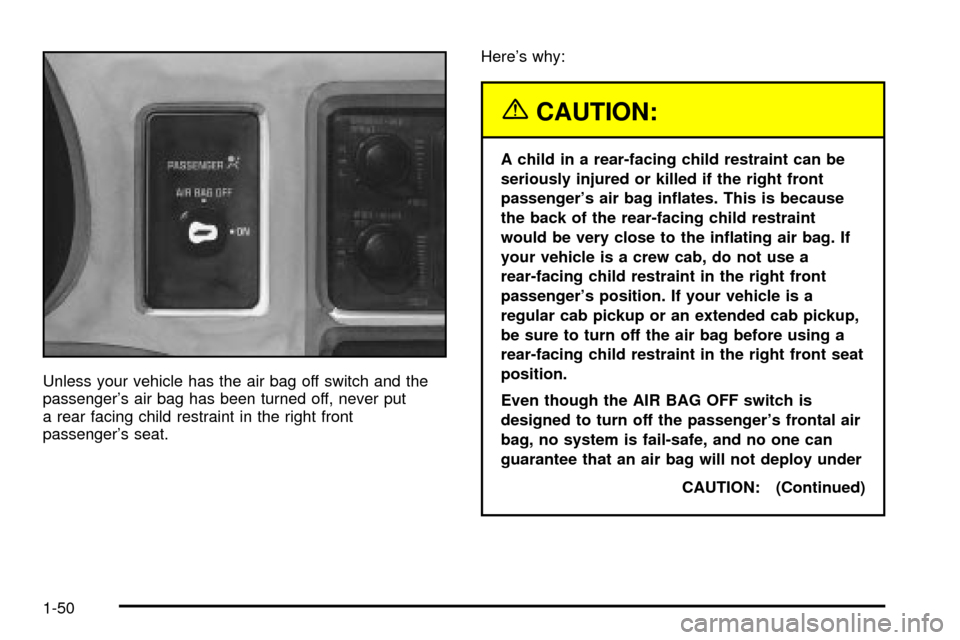
Unless your vehicle has the air bag off switch and the
passenger's air bag has been turned off, never put
a rear facing child restraint in the right front
passenger's seat.Here's why:
{CAUTION:
A child in a rear-facing child restraint can be
seriously injured or killed if the right front
passenger's air bag in¯ates. This is because
the back of the rear-facing child restraint
would be very close to the in¯ating air bag. If
your vehicle is a crew cab, do not use a
rear-facing child restraint in the right front
passenger's position. If your vehicle is a
regular cab pickup or an extended cab pickup,
be sure to turn off the air bag before using a
rear-facing child restraint in the right front seat
position.
Even though the AIR BAG OFF switch is
designed to turn off the passenger's frontal air
bag, no system is fail-safe, and no one can
guarantee that an air bag will not deploy under
CAUTION: (Continued)
1-50
Page 57 of 432
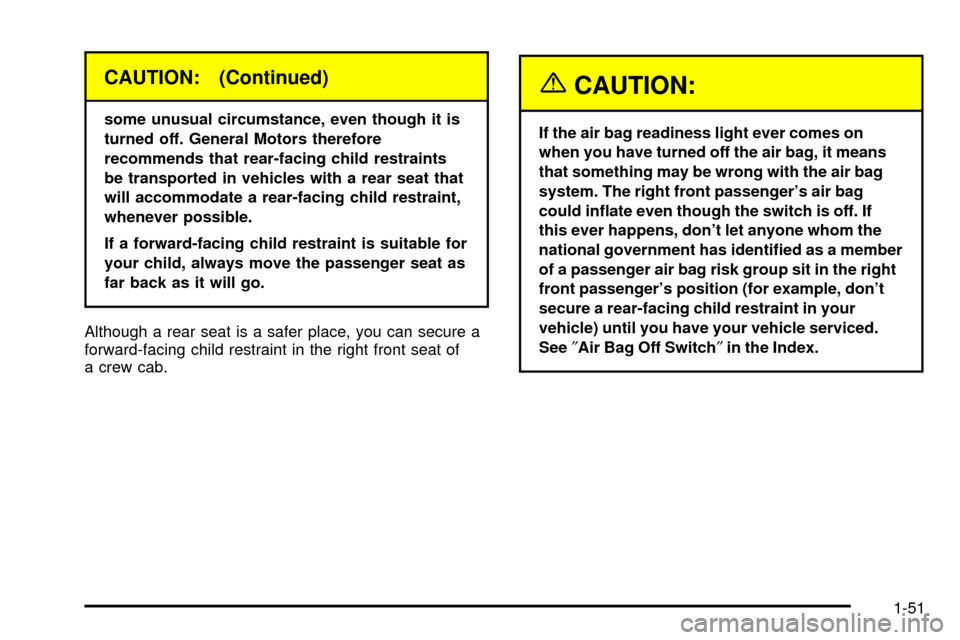
CAUTION: (Continued)
some unusual circumstance, even though it is
turned off. General Motors therefore
recommends that rear-facing child restraints
be transported in vehicles with a rear seat that
will accommodate a rear-facing child restraint,
whenever possible.
If a forward-facing child restraint is suitable for
your child, always move the passenger seat as
far back as it will go.
Although a rear seat is a safer place, you can secure a
forward-facing child restraint in the right front seat of
a crew cab.
{CAUTION:
If the air bag readiness light ever comes on
when you have turned off the air bag, it means
that something may be wrong with the air bag
system. The right front passenger's air bag
could in¯ate even though the switch is off. If
this ever happens, don't let anyone whom the
national government has identi®ed as a member
of a passenger air bag risk group sit in the right
front passenger's position (for example, don't
secure a rear-facing child restraint in your
vehicle) until you have your vehicle serviced.
See²Air Bag Off Switch²in the Index.
1-51
Page 58 of 432
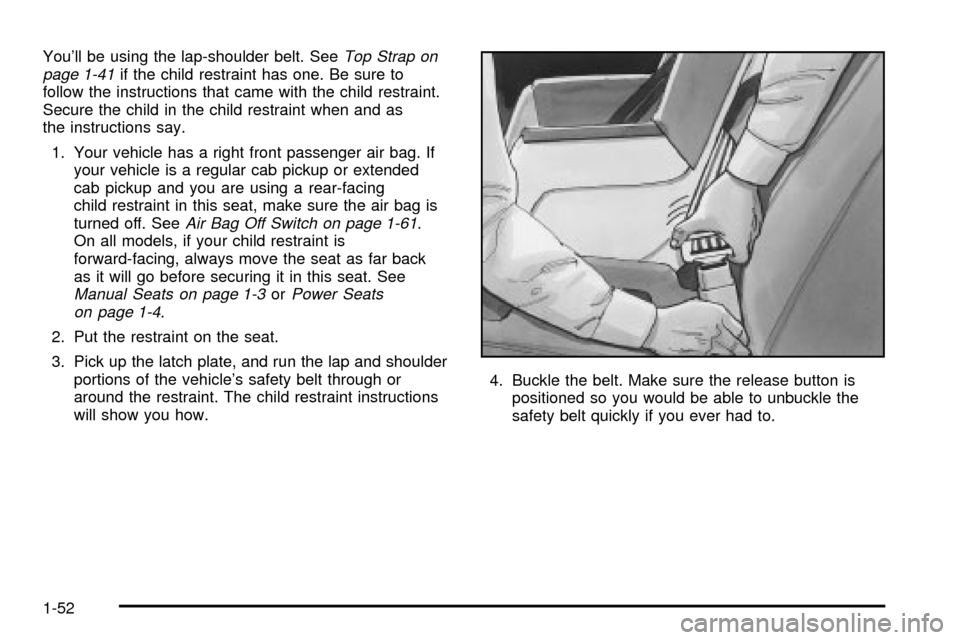
You'll be using the lap-shoulder belt. SeeTop Strap on
page 1-41if the child restraint has one. Be sure to
follow the instructions that came with the child restraint.
Secure the child in the child restraint when and as
the instructions say.
1. Your vehicle has a right front passenger air bag. If
your vehicle is a regular cab pickup or extended
cab pickup and you are using a rear-facing
child restraint in this seat, make sure the air bag is
turned off. See
Air Bag Off Switch on page 1-61.
On all models, if your child restraint is
forward-facing, always move the seat as far back
as it will go before securing it in this seat. See
Manual Seats on page 1-3orPower Seats
on page 1-4.
2. Put the restraint on the seat.
3. Pick up the latch plate, and run the lap and shoulder
portions of the vehicle's safety belt through or
around the restraint. The child restraint instructions
will show you how.4. Buckle the belt. Make sure the release button is
positioned so you would be able to unbuckle the
safety belt quickly if you ever had to.
1-52
Page 59 of 432
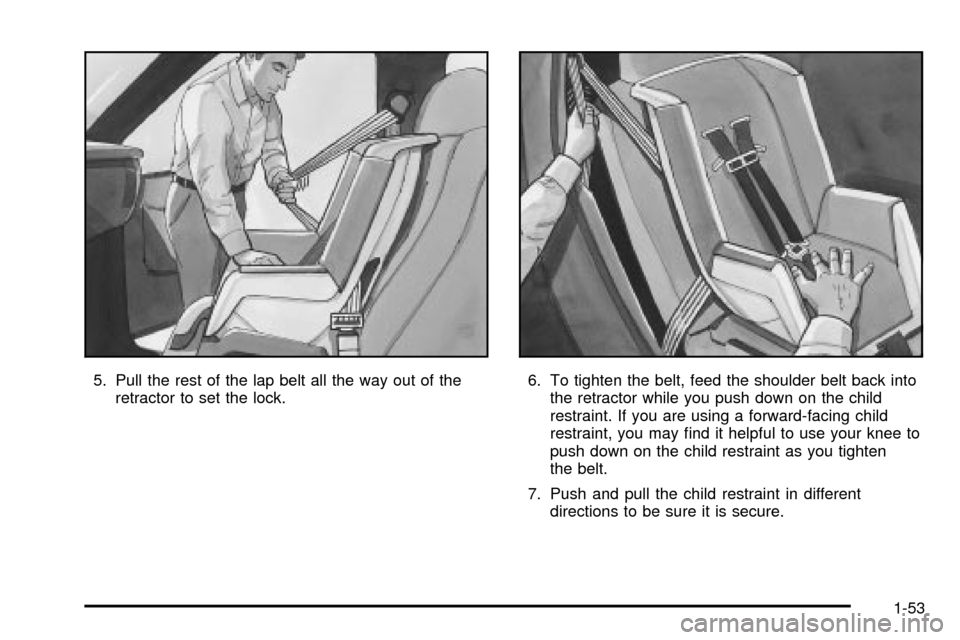
5. Pull the rest of the lap belt all the way out of the
retractor to set the lock.6. To tighten the belt, feed the shoulder belt back into
the retractor while you push down on the child
restraint. If you are using a forward-facing child
restraint, you may ®nd it helpful to use your knee to
push down on the child restraint as you tighten
the belt.
7. Push and pull the child restraint in different
directions to be sure it is secure.
1-53
Page 60 of 432
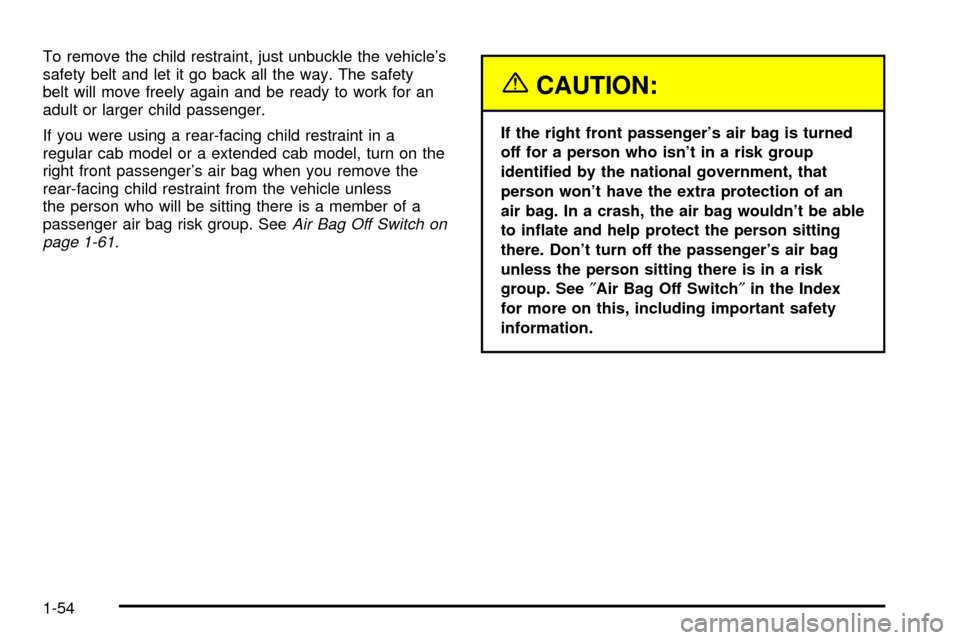
To remove the child restraint, just unbuckle the vehicle's
safety belt and let it go back all the way. The safety
belt will move freely again and be ready to work for an
adult or larger child passenger.
If you were using a rear-facing child restraint in a
regular cab model or a extended cab model, turn on the
right front passenger's air bag when you remove the
rear-facing child restraint from the vehicle unless
the person who will be sitting there is a member of a
passenger air bag risk group. See
Air Bag Off Switch on
page 1-61.
{CAUTION:
If the right front passenger's air bag is turned
off for a person who isn't in a risk group
identi®ed by the national government, that
person won't have the extra protection of an
air bag. In a crash, the air bag wouldn't be able
to in¯ate and help protect the person sitting
there. Don't turn off the passenger's air bag
unless the person sitting there is in a risk
group. See²Air Bag Off Switch²in the Index
for more on this, including important safety
information.
1-54